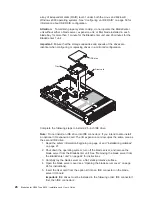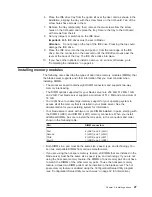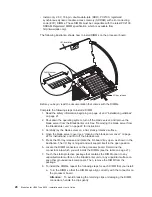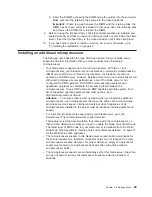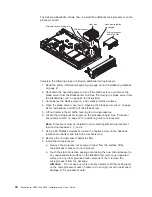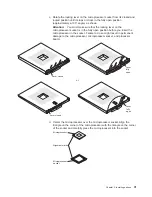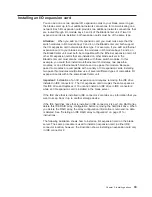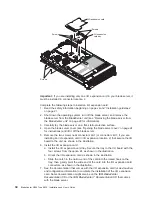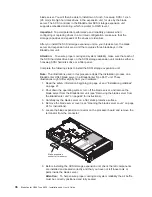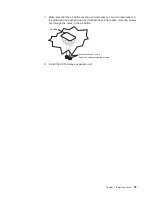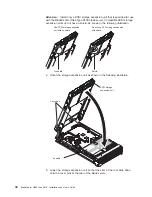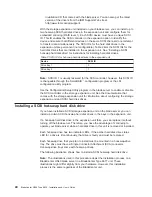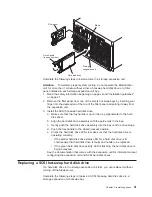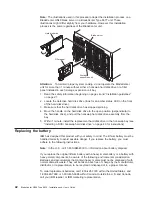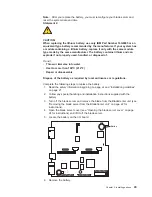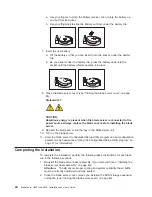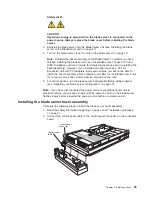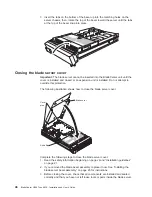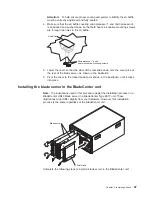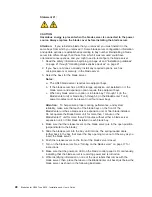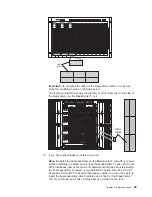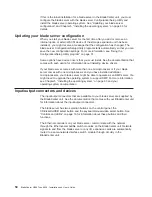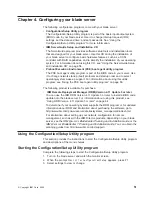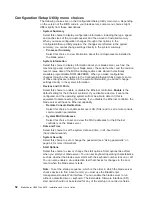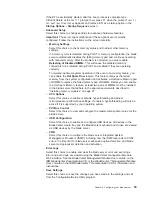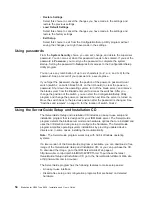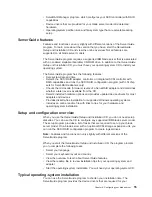
Installation
CD
that
comes
with
the
blade
server.
You
can
also
get
the
latest
version
of
the
drivers
from
the
IBM
Support
Web
site
at
http://www.ibm.com/pc/support/.
With
the
storage
expansion
unit
installed
on
your
blade
server,
you
can
install
up
to
two
hot-swap
SCSI
hard
disk
drives
in
the
expansion
unit
and
configure
them
for
embedded
mirroring
(RAID
level
1).
Each
SCSI
device
must
have
a
unique
SCSI
ID.
This
ID
enables
the
SCSI
controller
in
the
expansion
option
to
identify
the
device
and
ensure
that
different
devices
on
the
same
SCSI
channel
do
not
attempt
to
transfer
data
simultaneously.
The
SCSI
IDs
for
the
hard
disk
drives
in
the
expansion
unit
are
permanent
(not
configurable).
Table
2
lists
the
SCSI
IDs
for
the
hard
disk
drives
that
are
installed
in
the
expansion
unit.
See
“Installing
a
SCSI
hot-swap
hard
disk
drive”
for
instructions
for
installing
hard
disk
drives.
Table
2.
SCSI
IDs
for
hot-swap
hard
disk
drives
in
the
expansion
unit
Device
SCSI
ID
Drive
bay
1
0
Drive
bay
2
1
Note:
SCSI
ID
7
is
usually
reserved
for
the
SCSI
controller;
however,
this
SCSI
ID
is
changeable
through
the
ServeRAID
™
configuration
program
or
the
LSI
configuration
utility
program.
Use
the
Configuration/Setup
Utility
program
in
the
blade
server
to
enable
or
disable
the
SCSI
controller
in
the
storage
expansion
unit.
See
the
documentation
that
comes
with
the
storage
expansion
unit
for
information
about
configuring
the
storage
expansion
unit
and
SCSI
hard
disk
drives.
Installing
a
SCSI
hot-swap
hard
disk
drive
If
you
have
installed
a
SCSI
storage
expansion
unit
on
the
blade
server,
you
can
install
up
to
two
SCSI
hot-swap
hard
disk
drives
in
the
bays
in
the
expansion
unit.
If
a
hot-swap
hard
disk
drive
in
the
expansion
unit
fails,
you
can
replace
it
without
turning
off
the
blade
server.
Therefore,
you
have
the
advantage
of
continuing
to
operate
your
blade
server
while
a
hard
disk
drive
in
this
unit
is
removed
or
installed.
Each
hot-swap
drive
has
two
indicator
LEDs.
If
the
amber
hard
disk
drive
status
LED
for
a
drive
is
lit
continuously,
that
drive
is
faulty
and
must
be
replaced.
Each
hot-swap
drive
that
you
plan
to
install
must
be
mounted
in
a
hot-swap-drive
tray.
The
drive
must
have
a
Single
Connector
Attachment
(SCA)
connector.
Hot-swap-drive
trays
come
with
hot-swap
drives.
The
following
illustration
shows
how
to
install
a
SCSI
hot-swap
hard
disk
drive.
Note:
The
illustrations
used
in
this
procedure
depict
the
installation
process
on
a
BladeCenter
HS40
blade
server
in
a
BladeCenter
Type
8677
unit.
These
illustrations
might
differ
slightly
from
your
hardware.
However,
this
installation
process
is
the
same
regardless
of
the
BladeCenter
unit.
40
BladeCenter
HS40
Type
8839:
Installation
and
User’s
Guide
Summary of Contents for eServer BladeCenter HS40 Type 8839
Page 3: ...BladeCenter HS40 Type 8839 Installation and User s Guide ERserver ...
Page 8: ...vi BladeCenter HS40 Type 8839 Installation and User s Guide ...
Page 76: ...62 BladeCenter HS40 Type 8839 Installation and User s Guide ...
Page 90: ...76 BladeCenter HS40 Type 8839 Installation and User s Guide ...
Page 114: ...100 BladeCenter HS40 Type 8839 Installation and User s Guide ...
Page 118: ...104 BladeCenter HS40 Type 8839 Installation and User s Guide ...
Page 119: ......
Page 120: ... Part Number 90P3102 Printed in USA 1P P N 90P3102 ...

